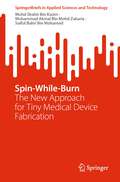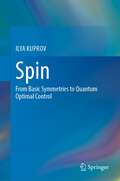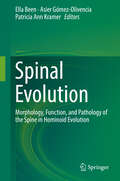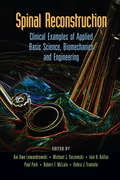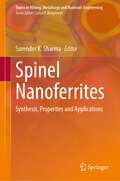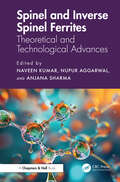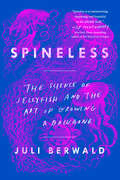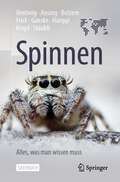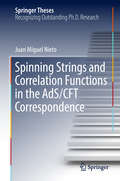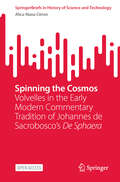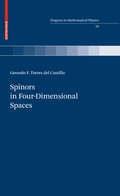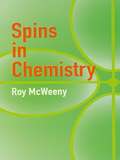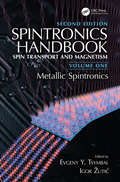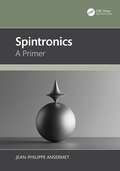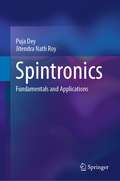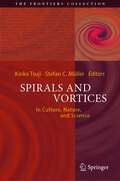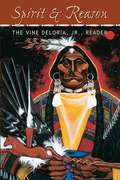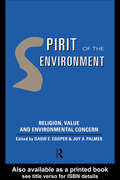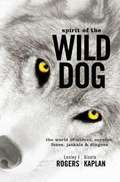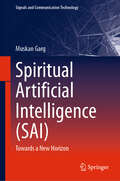- Table View
- List View
Spin-While-Burn: The New Approach for Tiny Medical Device Fabrication (SpringerBriefs in Applied Sciences and Technology)
by Saiful Bahri Mohamed Mohd Shahir Kasim Muhammad Akmal ZakariaThis book explains the challenges and advancements in cutting precise cylindrical shapes on difficult materials through spark erosion. Titled "Spin while Burn," it addresses the drawbacks associated with this process, including unsatisfactory surface finish and limited productivity. Despite utilizing advanced computing and statistical optimization methods, achieving the ideal balance between material removal rate (MRR) and surface quality remains elusive. In response, the book introduces a hybrid ultrasonic-assisted approach in the wire electrical discharge turning (WEDT) process. By integrating a rotating workpiece with ultrasonic vibration, the authors evaluate its impact on MRR and surface finish. Through meticulous design experiments and statistical analysis, they explore various cutting parameters and machining paths. The book highlights the characterization of machined surfaces through elemental analysis and surface morphology evaluations. The results demonstrate the positiveeffects of integrating ultrasonic vibration into WEDT, even without optimized ultrasonic parameters. By reducing electrode wire debris and employing multi-objective parameter optimization using the genetic algorithm, significant improvements are achieved in MRR and surface roughness compared to conventional WEDT. "Spin while Burn" consists of five chapters, delving into the challenges, history, principles, performance, and future perspectives of the Spin-while-Burn process in manufacturing. This comprehensive book offers valuable insights into enhancing surface quality and productivity in the cutting of precise cylindrical shapes on challenging materials through spark erosion.
Spin: From Basic Symmetries to Quantum Optimal Control
by ILYA KUPROVThis monograph is a fundamental reference for scientists and engineers who encounter spin processes in their work. The author, Ilya Kuprov, derives the concept of spin from basic symmetries and gives an overview of theoretical and computational aspects of spin dynamics: from Dirac equation and spin Hamiltonian, through coherent evolution and relaxation theories, to quantum optimal control, and all the way to practical implementation advice for parallel computers.
Spinal Evolution: Morphology, Function, and Pathology of the Spine in Hominoid Evolution
by Ella Been Asier Gómez-Olivencia Patricia Ann KramerThe vertebral spine is a key element of the human anatomy. Its main role is to protect the spinal cord and the main blood vessels. The axial skeleton, with its muscles and joints, provides stability for the attachment of the head, tail and limbs and, at the same time, enables the mobility required for breathing and for locomotion. Despite its great importance, the vertebral spine is often over looked by researchers because: a) vertebrae are fragile in nature, which makes their fossilization a rare event; b) they are metameric (seriated and repeated elements) that make their anatomical determination and, thus, their subsequent study difficult; and c) the plethora of bones and joints involved in every movement or function of the axial skeleton makes the reconstruction of posture, breathing mechanics and locomotion extremely difficult. It is well established that the spine has changed dramatically during human evolution. Spinal curvatures, spinal load transmission, and thoracic shape of bipedal humans are derived among hominoids. Yet, there are many debates as to how and when these changes occurred and to their phylogenetic, functional, and pathological implications. In recent years, renewed interest arose in the axial skeleton. New and exciting finds, mostly from Europe and Africa, as well as new methods for reconstructing the spine, have been introduced to the research community. New methodologies such as Finite Element Analysis, trabecular bone analysis, Geometric Morphometric analysis, and gait analysis have been applied to the spines of primates and humans. These provide a new and refreshing look into the evolution of the spine. Advanced biomechanical research regarding posture, range of motion, stability, and attenuation of the human spine has interesting evolutionary implications. Until now, no book that summarizes the updated research and knowledge regarding spinal evolution in hominoids has been available. The present book explores both these new methodologies and new data, including recent fossil, morphological, biomechanical, and theoretical advances regarding vertebral column evolution. In order to cover all of that data, we divide the book into four parts: 1) the spine of hominoids; 2) the vertebral spine of extinct hominins; 3) ontogeny, biomechanics and pathology of the human spine; and 4) new methodologies of spinal research. These parts complement each other and provide a wide and comprehensive examination of spinal evolution.
Spinal Reconstruction: Clinical Examples of Applied Basic Science, Biomechanics and Engineering
by Paul Park Kai-Uwe Lewandrowski Robert F. McLain Debra J. Trantolo Michael J. Yaszemski Iain H. KalfasWith an ever-expanding array of biomaterials and implant devices appearing in the field, Spinal Reconstruction: Clinical Examples of Applied Basic Science, Biomechanics and Engineering helps surgeons assess and utilize the latest technologies to improve the reconstruction of the spine and enhance the reconstitution of diseased spinal segments. With
Spinel Nanoferrites: Synthesis, Properties and Applications (Topics in Mining, Metallurgy and Materials Engineering)
by Surender K. SharmaThis book highlights the complexity of spinel nanoferrites, their synthesis, physio-chemical properties and prospective applications in the area of advanced electronics, microwave devices, biotechnology as well as biomedical sciences. It presents an overview of spinel nanoferrites: synthesis, properties and applications for a wide audience: from beginners and graduate-level students up to advanced specialists in both academic and industrial sectors. There are 15 chapters organized into four main sections. The first section of the book introduces the readers to spinel ferrites and their applications in advanced electronics industry including microwave devices, whereas the second section mainly focus on the synthesis strategy and their physio-chemical properties. The last sections of the book highlight the importance of this class of nanomaterials in the field of biotechnology and biomedical sector with a special chapter on water purification.
Spinel and Inverse Spinel Ferrites: Theoretical and Technological Advances
by Naveen Kumar, Nupur Aggarwal, and Anjana SharmaThis comprehensive book explores spinel and inverse spinel ferrites, focusing on their synthesis methods, structural characteristics, magnetic properties, and diverse applications. It offers a valuable resource for understanding how these materials are transforming fields such as electronics, energy conversion, sensing, biomedicine, agriculture, and environmental management. The book provides practical insights into synthesis methods, fabrication techniques, and the scale-up processes required to move these materials toward commercial applications. With a focus on recent advancements such as nanoscale engineering and surface modifications, the book offers readers insights into the commercial and practical potential of these materials across various industries. Delivers practical guidance on the synthesis, fabrication, and scale-up of these materials, addressing their commercialization prospects. Examines the role of spinel and inverse spinel ferrites in magnetic resonance imaging (MRI), exploring their applications in medical diagnostics and treatment. Discusses their effectiveness in electromagnetic interference (EMI) shielding, emphasizing the importance of ferrites in electronic and telecommunication devices. Provides insights into the application of ferrites as sensors, with a focus on their use in gas sensing, biosensing, and other diagnostic tools. Highlights photocatalytic activity and environmental remediation, showcasing how these materials help in pollution control, water purification, and sustainable energy solutions. This reference book is for students, researchers, and professionals in physics, materials science, and engineering who wish to deepen their understanding of spinel and inverse spinel ferrites and their interdisciplinary applications.
Spineless: The Science of Jellyfish and the Art of Growing a Backbone
by Juli BerwaldA former ocean scientist goes in pursuit of the slippery story of jellyfish, rediscovering her passion for marine science and the sea's imperiled ecosystems.Jellyfish are an enigma. They have no centralized brain, but they see and feel and react to their environment in complex ways. They look simple, yet their propulsion systems are so advanced engineers are just learning how to mimic them. They produce some of the deadliest toxins on the planet and yet are undeniably alluring. Long ignored by science, they may be a key to ecosystem stability.Juli Berwald's journey into the world of jellyfish is a personal one. Over a decade ago she left the sea and her scientific career behind to raise a family in landlocked Austin, Texas. Increasingly dire headlines drew her back to jellies, as unprecedented jellyfish blooms toppled ecosystems and collapsed the world's most productive fisheries. What was unclear was whether these incidents were symptoms of a changing planet or part of a natural cycle.Berwald's desire to understand jellyfish takes her on a scientific odyssey. She travels the globe to meet the scientists who devote their careers to jellies, hitches rides on Japanese fishing boats to see giant jellyfish in the wild, raises jellyfish in her dining room, and throughout it all marvels at the complexity of these alluring and ominous biological wonders. Gracefully blending personal memoir with crystal-clear distillations of science, Spineless reveals that jellyfish are a bellwether for the damage we're inflicting on the climate and the oceans and a call to realize our collective responsibility for the planet we share.
Spinnen - Alles, was man wissen muss
by Wolfgang Nentwig Jutta Ansorg Angelo Bolzern Holger Frick Anne-Sarah Ganske Ambros Hänggi Christian Kropf Anna StäubliSpinnen sind Super-Raubtiere und vertilgen alles, was sie überwältigen können. Dafür haben sie unglaublich gute Fangtechniken und mit der Spinnenseide ein Werkzeug entwickelt, das die Materialtechnik vor Neid erblassen lässt. Die Männchen sind meist kleiner als die Weibchen und müssen sich, um nicht als leichte Beute missverstanden zu werden, beim Sex einiges einfallen lassen: Tanzen, Trommeln und Geschenke helfen fast immer. Spinnen benutzen ihr Gift sehr genau dosiert, und da der Mensch nicht auf ihrem Speisezettel steht, sind sie für uns harmlos. Die (unnötige) Angst vieler Menschen vor Spinnen findet kulturelle Wurzeln bereits im Mittelalter. Trotzdem ist Spinnenangst leicht therapierbar. Es gibt weder einen Lebensraum noch ein Gebäude ohne Spinnen. Und das ist gut so, denn sie verfügen über faszinierende Eigenschaften und ihre Welt ist voller Überraschungen. Alles, was man hierzu wissen muss, wird in diesem Buch in verständlicher Sprache von Fachleuten für Laien erklärt. Zudem werden einige der häufigsten Spinnenarten in Haus und Garten mit Tipps zur Beobachtung kurz vorgestellt.
Spinning Strings and Correlation Functions in the AdS/CFT Correspondence (Springer Theses)
by Juan Miguel NietoThis book addresses several aspects of the integrable structure of the AdS/CFT correspondence. In particular it presents computations made on both sides of the AdS/CFT correspondence, at weak and at strong coupling. On the string theory side of the correspondence, the book focuses on the evaluation of the energy spectrum of closed string solutions moving in some deformed backgrounds that preserve integrability. On the gauge theory side, it explores various formal problems arising in the computation of two and three-point functions by means of the Algebraic Bethe Ansatz and the Quantum Inverse Scattering method. The book features numerous results on integrability in the context of the AdS/CFT correspondence. Self-contained and pedagogical, it includes general discussions and detailed presentations on the use of integrable systems techniques and their applications.
Spinning the Cosmos: Volvelles in the Early Modern Commentary Tradition of Johannes de Sacrobosco’s De Sphaera (SpringerBriefs in History of Science and Technology)
by Alica-Nana CitronThis open access book investigates the epistemological concept of and the knowledge transfer interwoven with the moveable paper wheels found in medieval and early modern books—the so-called &“volvelles.&” The earliest known volvelles emerged in the mid-thirteenth century and were cut out and installed by the reader, often appearing in books dealing with astronomical subjects. The brain processes and remembers images more easily than words—the so-called &“picture superiority effect&”—especially if the images move, making volvelles a useful method to help students of the Quadrivium memorizing the heavenly movements, thus the composition of a device embedded within a text promises a comprehensive insight into the didactic concepts of early modern knowledge transfer. The Tractatus de Sphaera by Johannes de Sacrobosco (1195–1256), the standard university textbook for astronomy from the thirteenth until the seventeenth century, was particularly noted as containing volvelles of different kinds. The project &“The Sphere,&” located at the Max Planck Institute for the History of Science in Berlin, has collected a corpus of 359 printed De sphaera editions, building a promising basis for examining different volvelles and placing the results in a cultural context. These volumes had never been analyzed in detail before, nor was there such a large corpus that could provide a quantitative database for such an investigation. The results of the book show that a book and knowledge tradition as widespread as that of the Sphaera contained more than one third of volvelles and was used in university teaching in the early modern period. For historians, this sheds light on a new aspect of movable paper instruments in university didactics and book history in the early modern period.
Spinors in Four-Dimensional Spaces
by Gerardo F. Torres del CastilloWithout using the customary Clifford algebras frequently studied in connection with the representations of orthogonal groups, this book gives an elementary introduction to the two-component spinor formalism for four-dimensional spaces with any signature. Some of the useful applications of four-dimensional spinors, such as Yang-Mills theory, are derived in detail using illustrative examples. Spinors in Four-Dimensional Spaces is aimed at graduate students and researchers in mathematical and theoretical physics interested in the applications of the two-component spinor formalism in any four-dimensional vector space or Riemannian manifold with a definite or indefinite metric tensor. This systematic and self-contained book is suitable as a seminar text, a reference book, and a self-study guide.
Spins in Chemistry
by Roy McweenyOriginally delivered as a series of lectures, this volume systematically traces the evolution of the "spin" concept from its role in quantum mechanics to its assimilation into the field of chemistry. Author Roy McWeeny presents an in-depth illustration of the deductive methods of quantum theory and their application to spins in chemistry, following the path from the earliest concepts to the sophisticated physical methods employed in the investigation of molecular structure and properties. Starting with the origin and development of the spin concept, the text advances to an examination of spin and valence; reviews a simple example of the origin of spin Hamiltonians; and explores spin density, spin populations, and spin correlation. Additional topics include nuclear hyperfine effects and electron spin-spin coupling, the g tensor, and chemical shifts and nuclear spin-spin coupling.
Spintronic Materials and Technology
by Y B Xu S M ThompsonFew books exist that cover the hot field of second-generation spintronic devices, despite their potential to revolutionize the IT industry.Compiling the obstacles and progress of spin-controlled devices into one source, Spintronic Materials and Technology presents an in-depth examination of the most recent technological spintronic developmen
Spintronics
by Claudia Felser Gerhard H FecherSpintronics is an emerging technology exploiting the spin degree of freedom and has proved to be very promising for new types of fast electronic devices. Amongst the anticipated advantages of spintronics technologies, researchers have identified the non-volatile storage of data with high density and low energy consumption as particularly relevant. This monograph examines the concept of half-metallic compounds perspectives to obtain novel solutions and discusses several oxides such as perovskites, double perovskites and CrO2 as well as Heusler compounds. Such materials can be designed and made with high spin polarization and, especially in the case of Heusler compounds, many material-related problems present in current-day 3d metal systems, can be overcome. Spintronics: From Materials to Devices provides an insight into the current research on Heusler compounds and offers a general understanding of structure-property relationships, including the influence of disorder and correlations on the electronic structure and interfaces. Spintronics devices such as magnetic tunnel junctions (MTJs) and giant magnetoresistance (GMR) devices, with current perpendicular to the plane, in which Co2 based Heusler compounds are used as new electrode materials, are also introduced. From materials design by theoretical methods and the preparation and properties of the materials to the production of thin films and devices, this monograph represents a valuable guide to both novices and experts in the fields of Chemistry, Physics, and Materials Science.
Spintronics Handbook, Second Edition: Volume One: Metallic Spintronics
by Igor Žutić Evgeny TsymbalSpintronics Handbook, Second Edition offers an update on the single most comprehensive survey of the two intertwined fields of spintronics and magnetism, covering the diverse array of materials and structures, including silicon, organic semiconductors, carbon nanotubes, graphene, and engineered nanostructures. It focuses on seminal pioneering work, together with the latest in cutting-edge advances, notably extended discussion of two-dimensional materials beyond graphene, topological insulators, skyrmions, and molecular spintronics. The main sections cover physical phenomena, spin-dependent tunneling, control of spin and magnetism in semiconductors, and spin-based applications.
Spintronics Handbook, Second Edition: Volume Three: Nanoscale Spintronics and Applications
by Igor Žutić Evgeny TsymbalSpintronics Handbook, Second Edition offers an update on the single most comprehensive survey of the two intertwined fields of spintronics and magnetism, covering the diverse array of materials and structures, including silicon, organic semiconductors, carbon nanotubes, graphene, and engineered nanostructures. It focuses on seminal pioneering work, together with the latest in cutting-edge advances, notably extended discussion of two-dimensional materials beyond graphene, topological insulators, skyrmions, and molecular spintronics. The main sections cover physical phenomena, spin-dependent tunneling, control of spin and magnetism in semiconductors, and spin-based applications. Features: Presents the most comprehensive reference text for the overlapping fields of spintronics (spin transport) andmagnetism. Covers the full spectrum of materials and structures, from silicon and organic semiconductors to carbon nanotubes, graphene, and engineered nanostructures. Extends coverage of two-dimensional materials beyond graphene, including molybdenum disulfide and study of their spin relaxation mechanisms Includes new dedicated chapters on cutting-edge topics such as spin-orbit torques, topological insulators, half metals, complex oxide materials and skyrmions. Discusses important emerging areas of spintronics with superconductors, spin-wave spintronics, benchmarking of spintronics devices, and theory and experimental approaches to molecular spintronics. Evgeny Tsymbal's research is focused on computational materials science aiming at the understanding of fundamental properties of advanced ferromagnetic and ferroelectric nanostructures and materials relevant to nanoelectronics and spintronics. He is a George Holmes University Distinguished Professor at the Department of Physics and Astronomy of the University of Nebraska-Lincoln (UNL), Director of the UNL’s Materials Research Science and Engineering Center (MRSEC), and Director of the multi-institutional Center for NanoFerroic Devices (CNFD). Igor Žutić received his Ph.D. in theoretical physics at the University of Minnesota. His work spans a range of topics from high-temperature superconductors and ferromagnetism that can get stronger as the temperature is increased, to prediction of various spin-based devices. He is a recipient of 2006 National Science Foundation CAREER Award, 2005 National Research Council/American Society for Engineering Education Postdoctoral Research Award, and the National Research Council Fellowship (2003-2005). His research is supported by the National Science Foundation, the Office of Naval Research, the Department of Energy, and the Airforce Office of Scientific Research.
Spintronics Handbook, Second Edition: Volume Two: Semiconductor Spintronics
by Igor Žutić Evgeny TsymbalThe second edition offers an update on the single most comprehensive survey of the two intertwined fields of spintronics and magnetism, covering the diverse array of materials and structures, including silicon, organic semiconductors, carbon nanotubes, graphene, and engineered nanostructures. It focuses on seminal pioneering work, together with the latest in cutting-edge advances, notably extended discussion of two-dimensional materials beyond graphene, topological insulators, skyrmions, and molecular spintronics. The main sections cover physical phenomena, spin-dependent tunneling, control of spin and magnetism in semiconductors, and spin-based applications.
Spintronics: A Primer
by Jean-Philippe AnsermetA sound understanding of magnetism, transport theory, spin relaxation mechanisms, and magnetization dynamics is necessary to engage in spintronics research. In this primer, special effort has been made to give straightforward explanations for these advanced concepts.This book will be a valuable resource for graduate students in spintronics and related fields. Concepts of magnetism such as exchange interaction, spin-orbit coupling, spin canting, and magnetic anisotropy are introduced. Spin-dependent transport is described using both thermodynamics and Boltzmann’s equation, including Berry curvature corrections. Spin relaxation phenomenology is accounted for with master equations for quantum spin systems coupled to a bath. Magnetic resonance principles are applied to describe spin waves in ferromagnets, cavity-mode coupling in antiferromagnets, and coherence phenomena relevant to spin qubits applications.Key Features:• A pedagogical approach to foundational concepts in spintronics with simple models that can be calculated to enhance understanding.• Nineteen chapters, each beginning with a historical perspective and ending with an outlook on current research.• 1200 references, ranging from landmark papers to frontline publications.
Spintronics: Fundamentals and Applications
by Puja Dey Jitendra Nath RoyThis book highlights the overview of Spintronics, including What is Spintronics ?; Why Do We Need Spintronics ?; Comparative merit-demerit of Spintronics and Electronics ; Research Efforts put on Spintronics ; Quantum Mechanics of Spin; Dynamics of magnetic moments : Landau-Lifshitz-Gilbert Equation; Spin-Dependent Band Gap in Ferromagnetic Materials; Functionality of ‘Spin’ in Spintronics; Different Branches of Spintronics etc. Some important notions on basic elements of Spintronics are discussed here, such as – Spin Polarization, Spin Filter Effect, Spin Generation and Injection, Spin Accumulation, Different kinds of Spin Relaxation Phenomena, Spin Valve, Spin Extraction, Spin Hall Effect, Spin Seebeck Effect, Spin Current Measurement Mechanism, Magnetoresistance and its different kinds etc. Concept of Giant Magnetoresistance (GMR), different types of GMR, qualitative and quantitative explanation of GMR employing Resistor Network Theory are presented here. Tunnelling Magnetoresistance (TMR), Magnetic Junctions, Effect of various parameters on TMR, Measurement of spin relaxation length and time in the spacer layer are covered here. This book highlights the concept of Spin Transfer Torque (STT), STT in Ferromagnetic Layer Structures, STT driven Magnetization Dynamics, STT in Magnetic Multilayer Nanopillar etc. This book also sheds light on Magnetic Domain Wall (MDW) Motion, Ratchet Effect in MDW motion, MDW motion velocity measurements, Current-driven MDW motion, etc. The book deals with the emerging field of spintronics, i.e., Opto-spintronics. Special emphasis is given on ultrafast optical controlling of magnetic states of antiferromagnet, Spin-photon interaction, Faraday Effect, Inverse Faraday Effect and outline of different all-optical spintronic switching. One more promising branch i.e., Terahertz Spintronics is also covered. Principle of operation of spintronic terahertz emitter, choice of materials, terahertz writing of an antiferromagnetic magnetic memory device is discussed. Brief introduction of Semiconductor spintronics is presented that includes dilute magnetic semiconductor, feromagnetic semiconductor, spin polarized semiconductor devices, three terminal spintronic devices, Spin transistor, Spin-LED, and Spin-Laser. This book also emphasizes on several modern spintronics devices that includes GMR Read Head of Modern Hard Disk Drive, MRAM, Position Sensor, Biosensor, Magnetic Field sensor, Three Terminal Magnetic Memory Devices, Spin FET, Race Track Memory and Quantum Computing.
Spirals and Vortices: In Culture, Nature, and Science (The Frontiers Collection)
by Stefan C. Müller Kinko TsujiThis richly illustrated book explores the fascinating and ubiquitous occurrence of spirals and vortices in human culture and in nature. Spiral forms have been used as elements in the arts for thousands of years, whereas their role in nature and science – from DNA and sea shells to galaxies – is still a topic of investigation in numerous fields. Following an introduction to the cultural history of spiral forms, the book presents contributions from leading experts, who describe the origins, mechanisms and dynamics of spirals and vortices in their special fields. As a whole the book provides a valuable source of information, while also taking the reader on an aesthetic and scientific journey through the world of spiral forms.
Spirit and Reason: The Vine Deloria Jr. Reader
by Vine Deloria Jr. Kristen Foehner Barbara Deloria Samuel ScintaA collection of Vine Deloria Jr.'s writings from books, essays, and articles, as well as previously unpublished pieces.
Spirit of the Environment: Religion, Value and Environmental Concern
by David E Cooper Joy A PalmerSpirit of the Environment brings spiritual and religious concerns to environmental issues. Providing a much needed alternative to exploring human beings' relationship to the natural world through the restrictive lenses of 'science', 'ecology', or even 'morality', this book offers a fresh perspective to the field. Spirit of the Enironment addresses: * the environmental attitudes of the major religions; * the relationship between art and nature; * the Gaia hypothesis; * the non-instrumental values which have inspired environmental concern. Contributors range from a variety of disciplines including philosophy, comparative religion, education and social anthropology, providing students with an intriguing survey on the role that spirituality and religion play in nature. This is a vital collection for those eager to examine the relationship between the spiritual and the environment.
Spirit of the Wild Dog: The World of Wolves, Coyotes, Foxes, Jackals and Dingoes
by Gisela Kaplan Lesley J. RogersCovers all aspects of wild dogs: their variety of species, and where and how they live in the wild. From the grey wolf to the dingo, the South American bush dog to the whistling hunter, wild dogs have been free spirits on every continent except Antarctica and have thrived in all environments-the hottest and driest parts of Africa and Australia, the wettest forests of New Guinea and South America and the coldest parts of the Arctic Circle. Spirit of the Wild Dog is an up-to-date and highly readable account of the skills, personalities and lifestyles of these dogs. Lesley Rogers and Gisela Kaplan, both highly acclaimed authors and researchers in animal behaviour, trace the ancestry and habitats of a vast range of canine species, and discuss how much of their spirit lives on in our pet dogs. The book takes us on a fascinating exploration of how wild dogs behave, communicate, socialise, mate and hunt. It also provides insights into the extraordinary group coherence of wild dogs, their faithfulness and intelligence, their ability to learn, remember and solve problems. While humans have long lived with, worked with, loved and nurtured pet dogs, we have a love/hate relationship with their relatives in the wild. The book discusses this and brings into question the future of the wild dog. Their numbers have been declining rapidly and many relatives of our best friend face extinction unless action is taken. Including spectacular photographs of dogs in their natural habitats, Spirit of the Wild Dog is an intriguing and much needed account of the world of these admirable animals.
Spiritual Artificial Intelligence: Towards a New Horizon (Signals and Communication Technology)
by Muskan GargThis unique book delves into the convergence of artificial intelligence (AI) principles—rooted in scientific knowledge and technological advancements—with the concept of spiritual wellness, exploring their significance in our increasingly automated and digitized world. The author offers a synthesis of two domains often perceived as distinct, appealing to both technologists and spiritual thinkers. Beginning with an exploration of the definitions and scope of "spiritual AI," the book encourages the quantification of spiritual wellness, illustrated through examples from current literature. It sheds light on the evolution of the spiritual quotient, presenting it as an integration of intelligence quotient (IQ) and emotional quotient (EQ), enhanced by dimensions of spirituality. The discussion spans various application domains and delves into the mind's entanglement-like phenomena, raising critical questions: Can a machine truly attain consciousness? How do spiritual wellness and quantum mechanics intertwine? The author invites readers to ask their own questions, contemplate the boundless possibilities of spiritual AI, and challenge existing paradigms.
